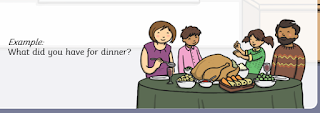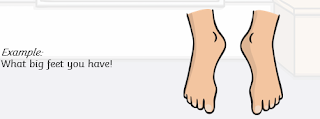This week in English we have
been learning about the four different types of sentences. They are
1. Statements – sentences which tell
you something (a fact). End with a full stop.
We wrote an example of each type of sentence. Some of us even tried to challenge ourselves to turn one type of sentence into another eg The weather is hot today into What is the weather like today?
You may like to help your
child think about the four different sentence types. We would love them to
bring their sentences into school to share.
On Tuesday we read and analysed the instructions we brought in
from home. We looked to see if the
instructions had certain features. By
the end of the lesson we had noticed that the instructions
·
Had
a title
·
List of materials/ingredients/introduction
·
Numbered/sequential steps
·
Start each new sentence on a new line
·
Use short, clear sentence
·
Use direct language – imperative/bossy verbs
·
Use of adverbs
On Wednesday we had a SpAG lesson where we
had to identify imperative verbs.
We
used a spinner to make up our own commands.
|
Look
at the words on the spinner. Can you choose an imperative verb and say or
write a command. How many different ways can you use that imperative verb?
On Thursday we worked in pairs to write a set of instructions
for our morning routine and on the following day we wrote our own set of
instructions for our morning routine.
We tried to include as many of the features we had identified in our
lesson on Tuesday.
More ideas for home learning.
This weekend see if you can provide the opportunity for your child to
·
Listen to and follow a series of more complex
instructions
·
Read and follow simple sets of instructions such
as recipes, plans, constructions which include diagrams
Next week
we will be continuing our learning about instructions.
Phonics – we have been learning
the trigraphs and homophones (words that sound the same but are spelt differently)
ear as in hear, ear as in pear, are as in care, air as in pair.
|
Spellings – we
have recapped the Year One words – were and was, says and said. Some strategies the children suggested to
help us remember was included it has ‘as’ in and it is saw backwards. With said you can hear
the s at the beginning and the d at the end but you need to remember the tricky
bit ai. What strategy does your child use?
We also practised
the Year Two words – find, kind, mind and child and children. Learn child and
then add ren.
Please keep practising the weekly words on the
blog and the Year One common exception words that we sent home before half term
as they are personalised for your child.
You will find them in their book bag.
Handwriting –
we practised the robot arm family letters n, m h and wrote the words ham, mend,
hand, them. Use the letterjoin website to practise at
home. The more the children can watch
the formation of the letters on the videoclips and have a go at forming the
joins for themselves the more fluent their cursive handwriting will become.
Remember every letter starts on the line and then leads into the join before
the letter is formed and then ends with a hook.
This week in maths, we have been building on our learning about
addition and subtraction. We started by adding a 1-digit number to a 2-digit
number. We made a list of strategies we could use:
We then moved onto using 2, 2-digit numbers. Here are some
examples, using the number sentence 24 + 12.
We can use our head and count on using our fingers, but as the
number get bigger, we need to use strategies that are more efficient. These include
using our number facts to add the ones and then add the tens.
The next day we subtracted 1-digit numbers from 2-digit numbers.
We could count back, but we tried to use our number facts to ensure we were
accurate.
We have then been adding 2, 2-digt numbers that ‘cross the tens’,
for example, 25 + 17. We can do this using our number facts to add the ones and
then the tens, using ‘sticks and bricks’ and using number lines. We have more
than ten ones we regroup, or exchange this for one ten. Here are some examples
of methods we have used:
Next week we will be subtracting 2-digit numbers, including ‘crossing
the ten’. We will be using our number facts and regrouping then, where needed.
Please keep practising number facts with your children as it helps their
confidence and accuracy.
We hope you have a good weekend and we might see you at the fireworks on Saturday!
Year Two Team










